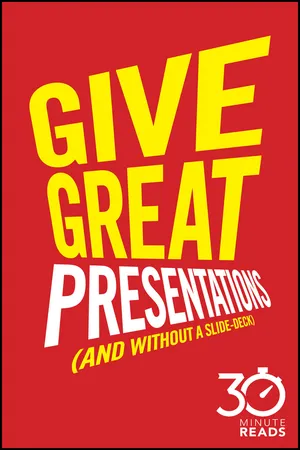
Give Great Presentations (And Without a Slide-Deck): 30 Minute Reads
A Shortcut to Better Presenting and Public Speaking
- English
- ePUB (mobile friendly)
- Available on iOS & Android
Give Great Presentations (And Without a Slide-Deck): 30 Minute Reads
A Shortcut to Better Presenting and Public Speaking
About this book
You're half an hour away from presentation greatness!
Why not use your next spare half an hour to skill-up? Each of these short e-books can be read in just 30 minutes. Addressing those painful work problems, and giving practical tools and expert advice to overcome them, the 30 Minute Reads series will make your work-life more productive, less painful and more successful!
Does the thought of giving a presentation leave you wanting to take really early retirement? Well hang on to your P45s because this succinct guide to better presentations will help you leave the power point behind, learn how to present yourself, pace your presentation and have the audience eating out of your hands in just 30 minutes.
Also available in a digital bundle with 4 other titles as part of 30 Minute Reads: The business skills collection.
Give Great Presentations will help you:
- Identify the problem and what isn't working
- Discover the 10 Big Strategies
- Put in place your super-structured, super-easy, 5-day count-down plan to no more pain.
Frequently asked questions
- Essential is ideal for learners and professionals who enjoy exploring a wide range of subjects. Access the Essential Library with 800,000+ trusted titles and best-sellers across business, personal growth, and the humanities. Includes unlimited reading time and Standard Read Aloud voice.
- Complete: Perfect for advanced learners and researchers needing full, unrestricted access. Unlock 1.4M+ books across hundreds of subjects, including academic and specialized titles. The Complete Plan also includes advanced features like Premium Read Aloud and Research Assistant.
Please note we cannot support devices running on iOS 13 and Android 7 or earlier. Learn more about using the app.
Information
The Challenge
The Detail
- They encourage reading: it takes a strong speaker to wrest the attention away from the written word. And so you are no longer in control.
- They encourage data overload. What does an audience participant do? Listen to the speaker, read the words …?
- They remove joined-up thinking and replace it with a series of bullets. PowerPoint slides have become increasingly attractive as they allow a series of words to be thrown at a screen. But rarely is much attention given to how such words are connected or fully explained. The bullets look good, they look definitive until they are given closer study …
- They quickly replace communication with content. And most critically, instead of a presenter concentrating on how he/she will get the message across, he/she becomes distracted by PowerPoint features.
- They are everywhere and because so many people have experienced such poor sessions, they are a little wary as they settle down to yours.
The Story
The Solution
The Challenge
Table of contents
- Cover
- Title page
- What will this book do for you?
- 1: Why Present?
- 2: Structure
- 3: Why You Should Create a Storyboard
- 4: Become a Good Storyteller
- 5: Slides: Less is More
- 6: Gaining Confidence
- 7: Challenges
- 8: The Other Presentations
- 9: Media: What Else is Available?
- 10: Your Action Plan
- About the Author
- Copyright page
- End User License Agreement